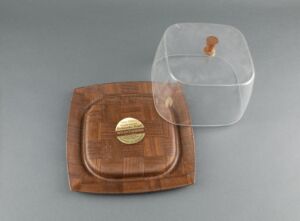June 4, 2019

Image from Hennepin History Museum collection
Hennepin County resident Howard H. Thompson innovated wooden dishware. After founding Weavewood Inc. in 1947, he worked with chemists to develop a manufacturing process that applied a resin to his first prototype, a wooden bowl. This new process made the wood non-absorbent. This development enabled Weavewood products could be used in restaurants. At the time, wooden dishware had been banned for commercial use because the material did not meet local sanitation guidelines. Thompson’s products did meet those guidelines and could soon be found in numerous restaurants and retail stores.
The platter that can be seen above, from the collection at Hennepin History Museum, is one of the products that was introduced after the initial bowl. The company would go on to develop an entire line of products in a variety of styles and woods. The platter above is made from walnut and came with a plastic lid. The original label is still attached to the product which boasts that in addition to being dishwasher-safe, it is also “virtually unbreakable.”
Thompson’s patent on his manufacturing process eventually expired, which meant that anyone could mass-produce similar products. Unfortunately, the company ultimately went out of business and closed its factory in Golden Valley. However, if you’re interested in getting your hands on an original, you can still purchase vintage woven-wood bowls, dishes, and plates that bear the Weavewood name online.
Written by Alyssa Thiede
Sources:
“Howard H. Thompson, Weavewood Founder, Dies,” Star Tribune, April 15, 1991. Star Tribune Archive.
Thompson, Howard H. Method of Molding Dishlike Articles. U.S. Patent 2,592,080 filed June 6, 1947, and issued April 8, 1952.
This publication was made possible in part by the people of Minnesota through a grant funded by an appropriation to the Minnesota Historical Society from the Minnesota Arts and Cultural Heritage Fund. Any views, findings, opinions, conclusions or recommendations expressed in this publication are those of the authors and do not necessarily represent those of the State of Minnesota, the Minnesota Historical Society, or the Minnesota Historic Resources Advisory Committee.

